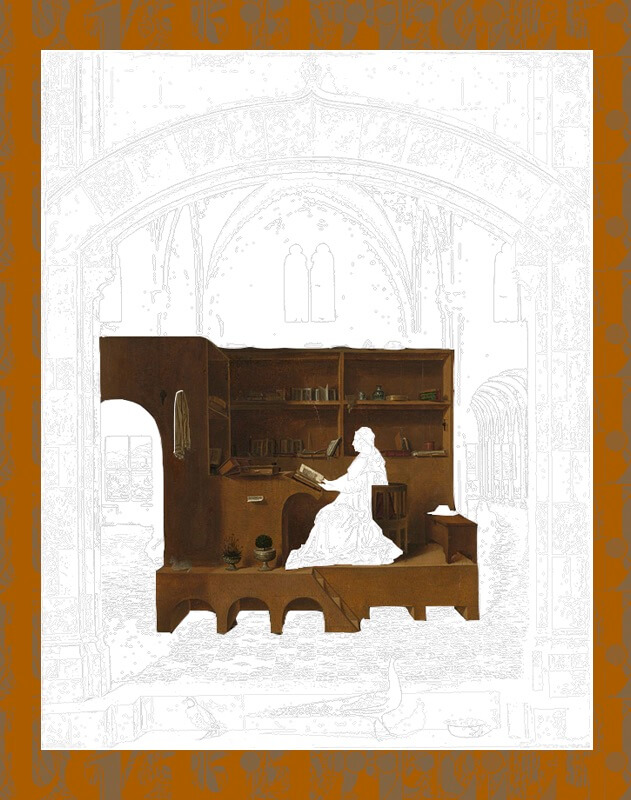
Maxwell Hyett, St Jerome in his Study (After Sheila Ayearst and Poststructuralism) – with brown border, 2022
In Antonello da Messina’s painting of Saint Jerome, completed around 1474 or 1475, we see the renowned theologian and historian sitting in an open-space study surrounded by his famous library. This almost stand-alone study is located within a larger architectural environment, our view of which is framed by an arched doorway that limits and focuses what we witness. The scene includes Jerome’s lion, strolling on a patterned floor that reaches into the background of the fictive room; on a stair in the foreground we are also shown two birds in profile, on the left a partridge (truth) and a rather curious peacock (immortality) on the right. Reflecting a Renaissance fascination with defining inner and outer worlds, the artist allows us to see through the windows in the back of this structure; in the lower ones a landscape and sky with birds in the upper ones, which help define the interiority of much of the representation. But the painting’s focus is unmistakeably on the rather peculiar study. A large writing desk is part of the architecture that, open on two sides and without a ceiling, includes the walls that define this fractional space; this study is also its own raised platform and arching extension that may—we cannot actually see—connect it to the larger architectonics of the building that contains it. There is a stage-like quality to this structure that puts the activities of the historian on display and makes obvious the foundational role of scholarship for Saint Jerome. As an early desert father, he was to, as he writes, cut himself off from home and parents, and sister and kin and what is harder than these, the habit of exquisite dining while in the desert for five years, but the library I had built up with such ardour and pains in Rome, I could not bring myself to do without. Isolating himself from civilization, the future saint could not part with his books, literally carrying his library with him as he walked the desert. Jerome becomes the patron saint of biblical scholars, librarians, students and translators. Of the many depictions of the saint, there is a tradition of showing him in the closed room of his study, often surrounded by his books and accompanied by his faithful lion. Albrecht Dürer’s 1514 print can stand as a paradigm. Jerome is pictured in a typical 16th century German study, seated at his desk with a book in front of him, the floor at his feet ends with a step in the foreground just before which are his lion and dog lay sleeping—light from windows on the side wall illuminates the room, a halo over the saint’s head frames his mental engagement. In place of a closed room Messina imagines Jerome in an open construct that invites modern interpretations. Scholarship is not simply contained, architecturally or otherwise, but instead exists as an artificial separation that consciously stages its interiority. The study described in Messina’s painting is not a closed world but rather a prelude to an infinite universe.
